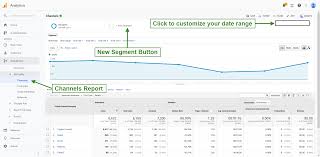Have you ever found yourself sitting at a table, looking at your unsold products, and wondering what’s wrong? Have you ever taken the time to analyze the results of your digital marketing strategies? Well… this article might just be for you. Running a digital marketing analysis for your products will not only save you time and resources but also help you avoid unnecessary mistakes. Having learned from experts, I’ll share some insights on how digital marketing analysis can help you transform your business.
Understanding Digital Marketing Analysis
Digital marketing analysis is the process of collecting, analyzing, and interpreting data from various digital marketing channels to understand the performance of marketing campaigns and make informed decisions. A digital marketing analysis researches and evaluates your business, audience, and competitors to build a custom, data-driven digital marketing plan for your company. With an online marketing analysis, your company can deliver an Internet marketing strategy that speaks to your audience — and converts them.
The Role of Data in Digital Marketing
Data is the backbone of digital marketing analysis. It includes information on website traffic, social media engagement, email marketing performance, and more. To collect this data, we use a variety of methods, such as tracking codes on websites, social media analytics tools, and email marketing platforms.
Key Components of Digital Marketing Analysis
#1. Website Analytics
By analyzing website traffic, you can find out which pages are attracting visitors to your site and which ones are causing them to leave. Understanding user behavior allows you to make targeted improvements, increasing user engagement and sales.
#2. Social Media Analytics
Social media analytics helps you to analyze data gathered from social channels to support your business decisions—and measure the performance of actions based on those decisions through social media. Personally, tools like Hootsuite provided engagement metrics and audience demographics, revealing what content resonated with my audience. This insight helped me tailor my social media strategy, resulting in higher engagement rates.
#3. Email Marketing Analytics
By tracking open rates, click-through rates, and conversions, you can refine your email campaigns. For instance, I learned that personalized subject lines significantly boosted open rates, leading to more sales.
#4. SEO and SEM Analytics
SEO and SEM analytics are both important for understanding how customers find your business online. Using SEMrush, I tracked keyword performance and ad campaign effectiveness, optimizing my content and ad spend to attract more organic and paid traffic.
Tools for Digital Marketing Analysis

#1. Google Analytics

Google Analytics offers a range of analytics for free, including knowing how many people visit websites from different places and what they did while on the site. This data can help decide which marketing strategies to focus resources on or where you need more traffic. You also have access to the Google ads platform by linking up with ads, making it easier than ever!
Google Analytics provides an extensive variety of marketing analytics functions like counting page views, tracking user behaviour such as time spent reading content and scrolling down pages, and understanding demographic information about who visits your website (for example, age). Setting up goals and funnels in Google Analytics helped me understand the customer journey, allowing me to identify and fix drop-off points.
#2. SEMrush
SEMrush helps you observe your competitors online. With SEMrush, you can see what keywords they are ranking for and monitor their social media accounts to avoid being left in the dust by them. You can also use it as an opportunity to keep track of how well your brand performs against theirs.
With SEMrush, you can learn more about your competition and how to best use keywords to capture the attention of potential customers. The analytics report tool displays data concerning their AdWords campaign; this gives users like you an opportunity for valuable information to help them stand out from competitors.
#3. Mixpanel
Mixpanel will help you track the events of your site or app. You’ll be able to see which actions users take on the site and in what order they took them. MixPanel is an easy way to monitor user activity on any website or mobile app (both Android and iOS). With their digital marketing analytics services integrated into your platform(s), you’ll have access to statistics like count per event type as well as insights based on who was using that feature first.
#4. Cyfe
Cyfe is a one-stop solution dashboard that enables marketers to see data from various marketing analysis tools in one place. It also incorporates prebuilt widgets that can be used for Google Analytics, Adwords as well as Sales Force accounts so you don’t have to go through the trouble of setting them up yourself! You’ll also get instant notifications on your phone or email when something goes wrong with a campaign page that you’re using, saving you countless hours of searching back and forth between different programs while trying to figure out what went wrong and where.
#5. Heap Analytics
Heap data analysis helps you trace any activity your online customers do constantly, and you can individually select and evaluate the occurrences you want to study in your platform. The platform also tracks individual consumer behaviour, which enables you to categorize individuals based on their behaviour.
#6. Oribi
Oribi is a new data analytics provider that promises to make smarter and faster decisions with a simple user interface. Oribi’s powerful features allow you to gather up 100% of your online-page events with the exception of the need for manual input or code changes, and it does this by automatically collecting everything, from visitors’ behavior on the site through conversion rates.
#7. KissMetrics
KissMetrics has a cognitive analytics technique to help you understand how users engage with each feature on your site or product and lets you know which features are working well for them so that you can improve their experience by focusing more time and attention there to increase user engagement. If it’s conversion rates where they need help, this data will show if making adjustments like tweaking text size or changing colors might be beneficial – without making any changes! You can create A/B tests and see what results are affected by any changes made, increasing conversion rates while making sure users stay engaged in the process!
#8. Formisimo
If you’ve ever noticed that when you fill out a form on the internet, it always seems to autofill your data, there’s an explanation for that. In fact, there’s an app for that! Formisimo uses real-time web analytics and 54 individual metrics to analyze why prospects are not converting from forms. From this insight, they can tell us where we’re slipping up with our conversion rates, so now we can do better in those areas before launching new projects or improvements of existing ones. Formisimo uses a web analytics component called w3Box, which takes things like search engine optimization, value, or conversion rate into account to create the best experience for you.
#9. BuzzSumo
BuzzSumo is a social media digital marketing analytics tool that can help you analyze the impact your content and social media presence have on your target audiences. Using these tools, you can determine where your content and marketing efforts are going wrong and make it right.
BuzzSumo is a very influential social media platform, and it has a post-evaluation dashboard that shows users which subjects are popular on all of the main social media platforms. You can also examine the information from a multitude of time intervals, including the last 12 hours or few months. It thus allows you to quickly discover which issues in your business are garnering the most momentum on social media.
You can see from this list that each tool caters to a particular need, so I’ve prepared a checklist to help guide you in choosing the one that works best for you. You can download it below:
Interpreting and Applying Data
#1. Setting Up Key Performance Indicators (KPIs)
KPIs are essential for measuring success. For my business, important KPIs included website traffic, conversion rates, and customer acquisition costs. By monitoring these KPIs, I could make data-driven decisions to improve performance.
#2. Data Visualization Techniques
Visualizing data makes it easier to understand and communicate insights. Tools like Tableau and Google Data Studio helped me create clear and compelling data visualizations, enabling better decision-making.
#3. Making Data-Driven Decisions
One of my proudest moments was launching a data-driven marketing campaign that resulted in a 30% increase in sales. By analyzing past performance and customer behavior, I crafted a targeted strategy that resonated with my audience.
Challenges in Digital Marketing Analysis
#1. Data Overload
In the beginning, I was overwhelmed by the sheer volume of data. Learning to filter and prioritize relevant data was key. I focused on metrics that aligned with my business goals, which simplified decision-making.
#2. Privacy Concerns and Regulations
Navigating privacy regulations like GDPR and CCPA was daunting. Ensuring compliance while maintaining effective data collection requires careful planning and the use of compliant tools and practices.
#3. Integrating Multiple Data Sources
Integrating data from various sources was another challenge. Tools like Zapier helped automate data integration, providing a unified view of my marketing performance and saving me countless hours.
Future Trends in Digital Marketing Analysis
AI and Machine Learning in Digital Marketing
AI and machine learning are transforming digital marketing. Predictive analytics and personalized experiences are becoming the norm. Embracing these technologies can give your business a competitive edge.
The Rise of Voice Search Analytics
Optimizing for voice queries is becoming more important with the increasing use of voice search. Tools that analyze voice search trends can help your business stay ahead in the SEO game.
Enhanced Customer Journey Mapping
Understanding the customer journey is crucial for delivering personalized experiences. Advanced tools for mapping customer touchpoints provide deeper insights, allowing for more targeted marketing efforts.
How To Do Market Analysis For Digital Marketing?
To perform market analysis for digital marketing, define your target audience, analyze competitors using tools like SEMrush, conduct keyword research with Google Keyword Planner, track website and social media analytics with Google Analytics and Hootsuite, and assess customer feedback for insights.
What Are The 7 Cs of Digital Marketing?
The 7 Cs of digital marketing are:
- Customer: Understand and prioritize customer needs.
- Content: Create valuable, relevant content.
- Context: Ensure content fits the context of its platform.
- Community: Build and engage a community.
- Convenience: Make interactions easy for customers.
- Consistency: Maintain consistent messaging and branding.
- Communication: Foster open, effective communication with customers.
How To Write Digital Marketing Analysis?
To write a digital marketing analysis, start by collecting data from tools like Google Analytics and SEMrush. Analyze website traffic, social media engagement, and email marketing performance. Identify trends, measure against KPIs, and make data-driven recommendations for improvement.
What is SEO In Digital Marketing?
SEO (Search Engine Optimization) in digital marketing is the practice of optimizing a website and its content to improve its visibility in search engine results pages (SERPs). This involves keyword research, on-page optimization, link building, and ensuring technical health, aiming to increase organic traffic.
In Conclusion,
Reflecting on my journey, I realize how digital marketing analysis has helped me to achieve success. By continuously analyzing and adapting, I could help businesses stay ahead of the competition and achieve sustainable growth. I encourage every business owner to leverage digital marketing analysis—it’s a powerful tool that can unlock tremendous potential.
Related Articles
- 2024 Digital Marketing Trends: What You Need to Know
- The Top 10 Digital Marketing Agencies In Nigeria You Need to Know
- How to Do Competitor Analysis in Digital Marketing: A Step-by-Step Guide
- WHAT IS MEDIA ANALYSIS: Definitions, Techniques, and Personal Insights






